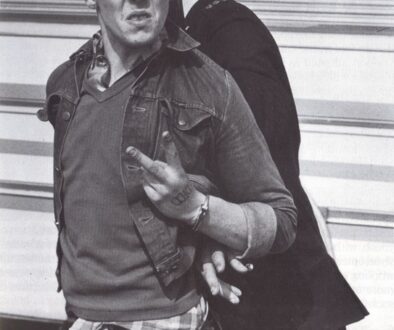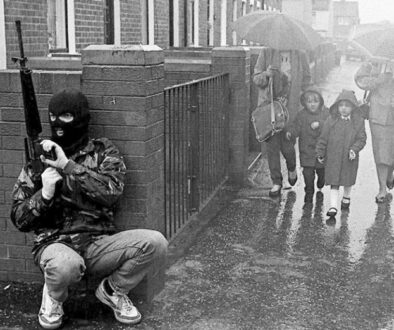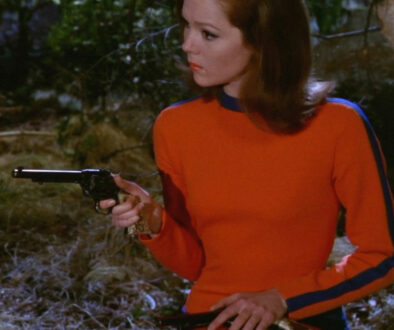We’ve Unpicked The Thread Of The World (The Last War in Albion Part 13: Roscoe Moscow, Arcade, Madness)
This is the third of seven installments of Chapter Three of The Last War in Albion, covering Alan Moore’s work for Sounds Magazine (Roscoe Moscow and The Stars My Degradation) and his comic stripMaxwell the Magic Cat. An omnibus of the entire chapter, sans images, is available in ebook form fromAmazon, Amazon UK, and Smashwords. It is equivalently priced at all stores because Amazon turns out to have rules about selling things cheaper anywhere but there, so I had to give in and just price it at $2.99. Sorry about that. In any case, your support of this project helps make it possible, so if you are enjoying it, please consider buying a copy.
PREVIOUSLY IN THE LAST WAR IN ALBION: Alan Moore’s earliest comics work was heavily indebted to the aesthetic of the American underground comix scene, pioneered by artists like R Crumb. But the publication that was really close to Moore’s heart was Arcade, a 1970s anthology of underground artists edited by Art Spiegelman and Bill Griffiths…
“There’s no going back. We’ve unpicked the thread of the world.” – Grant Morrison, The Invisibles #2
 |
| Figure 99: The sardonically bleak ending of R. Crumb’s “That’s Life!” (R Crumb, 1975) |
Arcade, in other words, was an ambitious publication.As Moore put it in his appreciation of the magazine, “Too Avant Garde for the Mafia” (the title comes from Griffiths’s reply to a letter Moore sent the magazine), “Arcade served as a rallying point for those cartoonists who were more concerned with their art than their bank balances,” although in the case of both Griffiths and Spiegelman (and for that matter Moore), it’s perhaps more accurate to say that they were concerned with the idea that the two might be interrelated. Nevertheless, Moore is wholly correct: Arcade was the venue for a wealth of impressive comics. Moore singles several out, not just by Crumb, but by second string underground artists like Spain Rodriguez, Justin Green, and Kim Deitch. But it is Moore’s praise of Crumb’s contributions to Arcade that is perhaps the most fascinating. Moore singles out a story in the third issue of Arcade entitled “That’s Life,” which tells the story of Tommy Grady, an obscure blues singer who recorded one record before being shot and killed in a barroom confrontation, then segues into a depiction of Crumb finding Grady’s lone record and plays it. As Moore describes it, “the last panel shows a crowd of rich white-American blues scholars smiling blissfully as Tommy Grady’s voice drifts around the elegant apartment: ‘Po-o boy, lo-ong way f’um home… Po-o boy lo-ong way f’um home…’ A lone caption reminds us of the title: ‘…And that’s life!’ Crumb at his manic-depressive zenith.”
 |
| Figure 100: Racist caricature persists even in R. Crumb’s less overtly parodic material such as “That’s Life!” (R Crumb, 1975) |
None of this is wrong as such. “That’s Life” is a well-worked story that builds skillfully to its bitter slap of a conclusion. But there’s an unsettling issue underneath this. Crumb’s depiction of Grady is clearly based on the tradition of racist “blackface” style cartoons, much as his Angelfood McSpade drawings are. And while Moore makes excuses for Angelfood McSpade, saying that her design was “so exaggerated that it called attention to the racialism inherent in all descriptions,” this argument falls flat when applied to the non-satirical depictions in “That’s Life.” The fact of the matter is, Crumb likes drawing black people in a caricatured style that is generally recognized as grotesquely racist, and Moore’s willingness to provide an apologia for it does him no favors. And although Moore singles out several female cartoonists in the underground scene for praise (including Melinda Gebbie, who he’d not yet met) in his 1983 essay “Invisible Girls and Phantom Ladies,” in both his 1988 “Comments on Crumb” essay and his 1984 “Too Avant Garde for the Mafia” piece, utterly silent on the rampant misogyny that’s present in Crumb’s work.
More damningly, these problems are not unique to Crumb. S. Clay Wilson’s work is similarly drenched in disturbing misogyny. Trina Robbins, an accomplished underground cartoonist in her own right and the force behind Wimmen’s Comix, an openly feminist underground comic, has complained vocally of “how willing people are to overlook the hideous darkness in Crumb’s work,” and blamed him directly for how “the underground comix of the Seventies [were] so full of hatred towards women; rape; degradation; murder and torture.” This suggestion of deeply entrenched misogyny is echoed by Melinda Gebbie, who describes the tremendous hostility directed at female comics artists, recounting a conversation in which S. Clay Wilson told her bluntly that “women aren’t supposed to be artists. They have babies, that’s what women are for.”
 |
| Figure 101: Moore illustrates what he views as positive contributions by women to comics in “Invisible Girls and Phantom Ladies,” published in The Daredevils #6 |
Moore is hardly alone in praising Crumb and Wilson and being willing to overlook their more disturbing aspects – the world is awash with Crumb apologists. Still, Moore’s relative silence on this issue is uncharacteristic. While there is a rich tradition of feminist criticism of Moore’s work, even his harshest feminist critics would largely agree that Moore is a committed feminist who makes some significant errors – far from Crumb, who, as Trina Robbins is quick to point out, openly admits that he’s “hostile to women.” Indeed, “Invisible Girls and Phantom Ladies” is an extended critique of the long and unfortunate history of sexism in comics. But despite pages of criticism about how female characters in superhero comics were “pale and limp carbon copies of their male counterparts” and of the countless “comic cuties who have been featured in ongoing gags-and-straps situations,” the extent of criticism he’s willing to subject the underground to is the staggering understatement that “whatever their other merits, I doubt anyone would hold up any of S. Clay Wilson’s panoramas of abused and dismembered women as a blow for feminism.”
One reason Moore might have been inclined to give Crumb and Wilson a pass is that he would have had obvious regard for the visionary quality of their work. In Crumb’s case, the bizarre sexuality of his comics work reflects his own issues, neuroses, and fetishes in a way that John Carlin describes as “not just directly autobiographical, but psychologically (and literally) naked… no one before Crumb made comics that were so directly about themselves and their own mental state.” The appeal is simple: Crumb could see things that others could not, and, specifically, could see them precisely because of the odd contours of his own internal psychological state. The fact that Crumb’s golden age began following his experimentations with LSD in the 1960s. He credited early experiments with LSD for driving him into a “fuzzy state of mind” where “the barrier betwixt the conscious and the subconscious was broken open somehow. A grotesque kaleidoscope, a tawdry carnival of disassociated images kept sputtering to the surface… especially if I was sitting and staring, which I often did.” Crumb admits that “it was difficult to function in this condition” and says, “I was certifiably crazy. I sat staring on the couch at Marty’s apartment, or on long aimless bus rides around Chicago.” Lest one think the experience was pleasant, he clarifies, “these jerky animated cartoons in my mind were not beautiful, poetic or spiritual, they were like an out-of-tune player piano that you couldn’t shut off… pretty disturbing…” And yet out of this period of madness he created “all the main characters I would be using in my comics for the next ten years,” describing the overall period as “a once-in-a-lifetime experience, like a religious vision that changes someone’s life, but in my case it was the psychotic manifestation of some grimy part of America’s collective unconscious.”
The War is littered with experiences analogous to this. Moore has described several such visionary experiences over the years, many shared with Steve Moore. Moore describes one, which took place on January 7th, 1994: “The ceiling’s gone, the room now opening upon a space above that isn’t night, and something stoops, leans in from outside, gathering identity with its approach. It pushes its unfathomable face down into our aquarium, displacing world, spilling reality on heaven’s front-room floor.” Morrison had a comparable experience a few months later in Kathmandu in which he “began to lose contact with the physical reality of the room, seeing in its place cranky ancient streets, and leaning ceramic houses haunted by gnomish presences, the current dragging me deeper through hallucinatory ancestral wynds and crabby cobbled alleyways that felt like the archaic half-remembered dreams of childhood.” Both these visionary experiences were profoundly influential, and are arguably two of the most significant events in the War.
These visionary experiences often seem to exist at the points of intersection between psychotropic substances, artistic talent, and mental illness. Where Moore and Morrison have copious experience with the former two, William Blake had similar experiences on the basis of the latter. Blake describes one such experience – a visitation from the archangel Gabriel, saying that he was “aware of a shining shape, with bright wings, who diffused much light. As I looked, the shape dilated more and more: he waved his hands; the roof of my study opened; he ascended into heaven; he stood in the sun, and beckoning to me, moved the universe.” Blake had such visions throughout his life, and depicted them in his work, as in Milton where he describes how,
Walking in my Cottage Garden, sudden I beheld
The Virgin Ololon & address’d her as a Daughter of Beulah
Virgin of Providence fear not to enter into my Cottage
What is thy message to thy friend? what am I now to do
Is it again to plunge into deeper affliction? behold me
Ready to obey, but pity thou my Shadow of Delight
Enter my Cottage. comfort her, for she is sick with fatigue
 |
| Figure 103: Blake receives a vision in Milton a Poem (Copy C, 1811) |
There is a power to these lines; the Shadow of Delight refers to Blake’s wife, Catherine, whose marriage to Blake Peter Ackroyd describes as “one of the most poignant relationships in literary history.” The image of Blake begging his angelic visitor to think of Catherine’s suffering while simultaneously admitting his willingness “to plunge into deeper affliction” if that is what should be asked of him is a haunting portrait of the delicate balance of sanity that such visionary creativity entails. Blake further suffered from what he described as “Nervous Fear,” which frequently manifested as a searing anger that often left him alienated and was a major contributor to his often faltering career.
For Crumb the visionary potential of psychotropic substances blended unnervingly with mental illness. Crumb’s two siblings also had artistic careers, but theirs were more visibly pocked by madness. His brother Maxon is a reasonably successful artist in his own right, but his working habits speak to deep-lying troubles beyond Crumb’s. He sits upon a bed of nails to stimulate focus and engages in twelve hour meditations, and describes his working habits as a fugue state in which he’ll forget to eat for long periods. In Terry Zwigoff’s 1995 documentary Crumb Maxon describes following and physically assaulting a woman, and he continues to practice a cleansing ritual in which he swallows a long strip of cloth to alleviate stomach pains that he believes to be karmic debt incurred from his father’s shooting of a beggar in 1938. Robert Crumb’s older brother Charles admitted to pedophilic desires that he never acted upon, and lived with his mother for his entire life. He continued to draw, but his artwork displayed an obsessive distaste for negative space common to those with mental illnesses. In 1993, Charles Crumb committed suicide, having failed in several earlier attempts that he describes in the Zwigoff film.
 |
| Figure 104: Robert Crumb’s younger brother Maxon Crumb |
The visionary quality of Crumb’s work would have held obvious appeal for Moore, who was kicked out of school in 1971 for dealing LSD “purely for ideological reasons.” This period clearly involved some profound psychological experiences for Moore. Although he rarely talks about it in detail, he’s noted that “the problem with being an LSD dealer, if you’re sampling your own product, is your view of reality will probably become horribly distorted and you may believe you have supernatural powers and you are completely immune to any form of retaliation and prosecution, which is not the case.” In other interviews he’s described himself as “sociopathic” during this period. Although this period did not give Moore the clarifying mystic vision that his later magical work did, the experience was still profound for him. As he put it, “LSD was an incredible experience… it hammered home to me that reality was not a fixed thing. That the reality that we saw about us every day was one reality, and a valid one – but that there were other, different perspectives where different things have meanings that were just as valid.”
 |
| Figure 105: The psychedelia of the 1960s depicted in Promethea #12 (Alan Moore and J.H. Williams III, 2001) |
For all his obvious affection for psychotropic substances, Moore’s discussions of his drug use demonstrate an investment in balancing visionary madness with practicality. He speaks witheringly of recreational drug use, and distinguishes “between drawings inspired by LSD and drawings attempted while under the effects of LSD.” Moore’s comments in Promethea on the decline of 1960s psychedelia are apropos in more ways than one: “Alas the zeitgeist’s solar flash / scorched most such visionaries to ash / their lives, confused, addicted, lame, / drugged melodramas now became.” Moore’s 1971 expulsion seems to have been a literally sobering lesson to him – he eventually stopped using LSD, and restricts his use of psilocybin to ritual contexts, noting that he does proper, formal ritual increasingly rarely.
While the underground clearly appealed to Moore on an ideological level despite the ethical failings of its leading lights, it is also worth discussing the aesthetic appeal. The gratuitous excess of the underground in and of itself is an odd fit for someone as focused on intricate structure as Moore. The tone of his praise in “Too Avant Garde for the Mafia” is telling – when he praises artists, it’s for things like being “creatively self-conscious in his use of the medium,” and the moments he chooses to single out are things like the final images of a biography of Stalin: “The narrative caption boxes relate how, during his final years, Stalin would travel by car along highways built for his solitary personal use across Russia. [continued]






October 10, 2013 @ 12:23 am
Not that much to say, as we'll still in territory I'm not that familiar with. I do know we'll be coming back and back to DAREDEVILS, since that title has an insane amount of Alan Moore material beyond Captain Britain. I'm really looking forward to what you have to say about Night Raven; given that most people know it (if they know of it at all) as a precursor to V.
Really not much to add, just wanted to remind you there are people reading and enjoying this. And I figured it deserved at least one semi on topic post before the Doctor Who discussion blows up later today. 🙂
December 5, 2019 @ 5:39 am
Хэллоу май френд я сегодня узнал что в 1xbet появился увеличенный бонус и что, для его получения, необходим специальный промокод. Какой промокод на 1xbet нужно вводить?
December 10, 2019 @ 7:52 am
Доброго денечка я раньше не знал что в 1xbet доступен новый увеличенный первый бонус и что, для его получения, требуется специальный промокод. Какой промокод на 1xbet нужно вводить?
August 6, 2020 @ 10:44 pm
lso you can take in this there [url=https://antivirusmonster.com/]https://antivirusmonster.com/[/url]
September 18, 2020 @ 8:06 am
🙂 [url=https://sioneinkerem.info/ ].[/url]
October 10, 2013 @ 1:34 am
Still enjoying this immensely, another illuminating post. Never mind Watchmen, V etc. Promethea really is Moore's most personal and revealing work isn't it?
October 10, 2013 @ 8:56 am
Again fascinating. Our tendency to categorize history (cultural or otherwise) into eras can make use forget tight connections between cultural movements. It is easy to think of Moore primarily in terms of 80's Britain but he brought with him the counterculture of the late 1960s.
October 10, 2013 @ 8:58 am
I think his outright most personal and revealing is The Birth Caul, but Promethea is right up there.
October 10, 2013 @ 8:59 am
I've not read the Night Raven short stories yet, but I am quite interested in what I'll have to say as well. 🙂
October 10, 2013 @ 9:29 am
Let me know if you need any of them. I'm sure you have copies of all the Moore written ones, but I've got all but 2 of the text stories by other authors as well, including all the Jamie Delano stories.
October 10, 2013 @ 9:34 am
I've got a complete run of The Daredevils, though I'll need to hunt down some of the pre-text Night Raven appearances at some point. Still, I can probably manage that. 🙂
October 10, 2013 @ 11:00 am
I feel as though I must just be missing it in the text, or ignorant of something obvious, but what's the source for Figure 102?
October 10, 2013 @ 11:02 am
It's the cover of Alan Moore's spoken word CD "Snakes and Ladders," which I talked about a bit on Eruditorum here: http://www.philipsandifer.com/2012/12/pop-between-realities-home-in-time-for_12.html
October 10, 2013 @ 11:23 am
Ah, that's right, thanks!
October 10, 2013 @ 12:00 pm
You probably can. If you can't I've got at least the first 14 (of 20) chapters from when they were reprinted in Captain Britain.
I figured you had the Daredevils, and for that matter the Marvel Super-Heroes and the Mighty World of Marvels; and probably the Captain Britains. What I figured you might be missing were the Savage Actions and the Savage Sword of Conans. There's probably nothing relevant to the war in the Savage Action stories, honestly; but the SSoC's are by Jamie Delano and might have at least some bearing.
October 10, 2013 @ 4:14 pm
Moore's work inspired my experimentations. Take that as you will.
October 10, 2013 @ 4:49 pm
One thing that's fascinating about Crumb is that he's one of handful of artists whose work seems to represent the '60s counterculture—he's up there with Dylan, Hendrix, people like that—yet he basically had contempt for '60s counterculture. A hippie icon who hated hippies, even if he shared some of their taste in drugs and comics.
October 10, 2013 @ 4:52 pm
By the way: Will you eventually be covering the Kool-Aid comic that Alan Moore did with Peter Bagge? One of my favorite entries in either man's C.V., though I wouldn't call it a "major work" in the usual sense of the phrase.
October 11, 2013 @ 12:19 am
Oh yes The Birth Caul is amazing.
October 12, 2013 @ 7:34 pm
And it's by John Coulthart.
BTW, where does Moore speak witheringly of recreational drug use?
October 14, 2013 @ 10:52 am
Sorry to have been slow answering this – I got it from a 2009 interview in Mustard Magazine, which I have in the University of Mississippi Press Alan Moore: Conversations volume. The relevant quotes are "I don't take anything purely for entertainment's sake, which I think is perhaps my saving grace. We are certainly not the first culture to have drugs, but we may well be one of the first to have a drug problem. I think there is a place for drugs in society, but it's a shamanic space that we don't really have anymore." And, subsequently, "In our current society, the only context we have to take drugs is in a leisure context, which a lot of time is disastrous."
February 15, 2015 @ 9:53 am
Having not been able to read when it was first posted, I have to say I am loving this Phil as you go over some work I am very familiar with and explore areas I have never been before. Great, inspiring stuff and learning much.